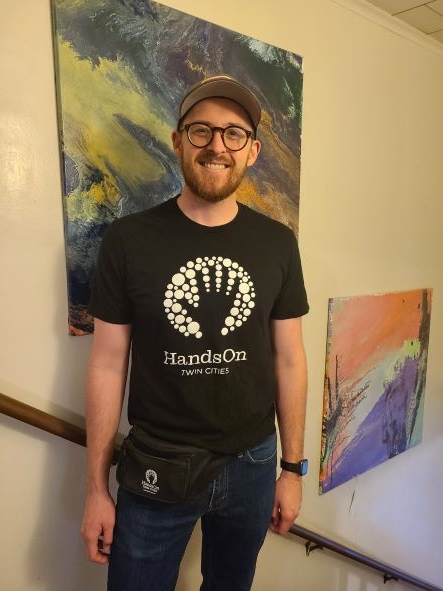Practicum Project: Seth Anderson Spotlight Story
| by Dion Miller

MIIS students have several options when completing their practicum semester including IPSS, advanced program evaluation, independent practicum project, and the practicum project led by Professor Maha Baimyrzaeva. This week we highlight Professor Baimyrzaeva’s practicum project through Seth Anderson, an MPA student working with HandsOn.
Tell us about yourself and where you are doing your practicum?
I’m originally from Napa, CA, but just moved to Minneapolis, MN last year and I’m doing my practicum project with the Corporate Projects Team (CPT) at HandsOn Twin Cities (HOTC). It’s a volunteer mobilization organization that seeks to impact the community by connecting nonprofits, volunteers, and corporations. We’re working with a hybrid format where I’ll work at home and occasionally in the office with the team. I also have the wonderful opportunity to work with Professor Mahabat Baimyrzaeva via Zoom.
How did you secure your position or positions?
My studies and conversations with my colleagues in the MPA department piqued my interest in how the nonprofit and corporate sectors work together to resolve systemic issues in their communities. In May, I came across HandsOn Twin Cities while searching on a career opportunities database recommended by advisor Scott Webb called GoinGlobal. I applied for a position with the Corporate Projects Team; however, my interests and their needs fit better with their Pro Bono Advisory Program (PBAP) at that time. I worked on their data collection tools and impact report outlines to help better communicate the progress and impact of their Pro Bono projects. After completing an internship with the PBAP, they asked me to stay on and assist with the impact reporting for the CPT. The opportunity to pair this work with the MPA practicum project happened to be the perfect fit!
What does your position entail? What are your duties and what are tasks you do that weren’t listed in the posting?
My position started with analyzing how the CPT shares the impact and progress of their in-kind volunteer projects. After some initial findings and discussions, we’ve taken this opportunity to assess the evaluability and draft a new Monitoring and Evaluation Plan for their in-person community volunteer projects. My position entails doing some internal and external research on best practices for monitoring and evaluating volunteer projects, creating data collections tools for the various volunteer activities, and facilitating interviews and focus groups with representatives from HOTC, local corporations, and local nonprofits to better understand their wants and needs for the volunteer projects and how we share that information to their communities.
What is one specific project you are a part of that you have spent the most time on, and what are your roles in that project?
A relatively new piece to the puzzle is the addition of service-learning activities for the volunteer to do before the start of the project. We’re looking to engage with the volunteers about their reasons for volunteering and reflect on our biases and privilege before we enter these communities. We’re figuring out how we can work these activities into the entire volunteer project process. This is a new project; however, I do see it consuming a good portion of our time.
What did you learn at MIIS and in your program that has been beneficial for your duties in your positions?
I honestly don’t know where to start. There are so many strategies and tools. I’ve learned how to organize and communicate the applied research process from my courses with Professor Maha. I’ve learned about the intricacies of data collection and how to facilitate them from Professors Netta Avineri and Peter Fordos. I’ve learned about the M&E process as well as the capacity for many Nonprofits to implement new practices from Professors Scott Pulizzi and Kent Glenzer. I know I’ve learned more and will continue to learn as the project continues.
What has been an unexpected challenge you have faced in your practicum?
It would be setting boundaries for the scope of the project. There are so much research and new practices in M&E and volunteer mobilization projects. I’ve had a difficult time narrowing the parameters and saying no to other aspects of the work. We only have so much time to dedicate to this work.
Do you have any advice for current and future students in your program?
Clarify your role and preferred forms of communication that work for you and your client. Don’t be afraid to set boundaries and say you don’t have the capacity to work on this aspect. It can be uncomfortable at first, but it will help you and your client in the long run.
For More Information
Professor Maha Baimyrzaeva
